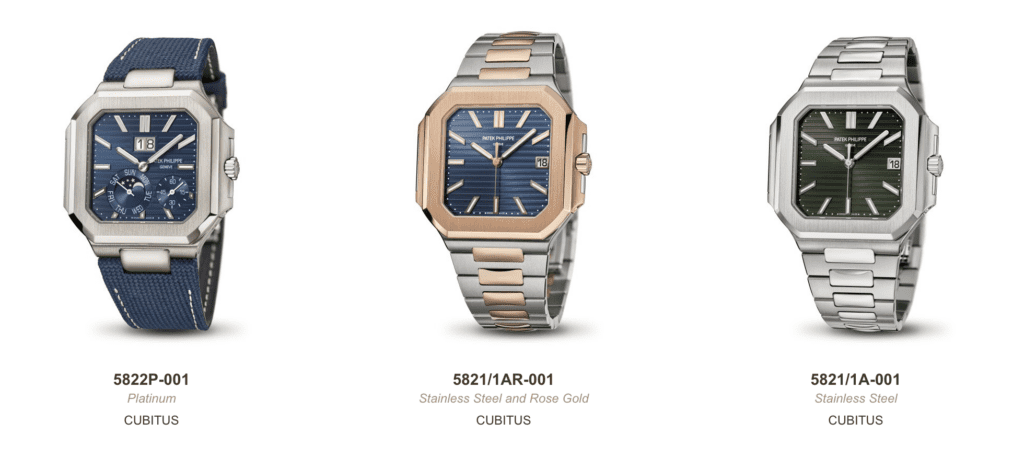Patek Philippe’s Cubitus collection has already been on the radar of watch enthusiasts, thanks to early leaks and speculations. The leaked images hinted at something new and exciting, sparking curiosity about how the brand might be evolving. The leaked images hinted at a stainless steel timepiece with a blue strap and moon phase complication, sparking conversations about whether this would be Patek’s answer to the growing demand for more accessible sports watches.

The anticipation surrounding the Cubitus collection wasn’t just about design—it was about what it might represent. Could Patek Philippe, a brand synonymous with exclusivity and elegance, be taking a calculated step to appeal to a broader audience while staying true to its roots? Now that the collection has officially been revealed, it’s clear that Patek has stayed true to its heritage of exclusivity, even while introducing new elements.
The Timepieces: Focus on Design and Features
The Cubitus collection debuts with three models, showcasing a departure from Patek’s more familiar silhouettes. Leading the lineup is the reference 5821/1A, a 45mm stainless steel piece featuring an olive green, horizontally embossed dial. While the use of stainless steel might suggest a more approachable price point, this model still commands $41,000, placing it firmly within luxury territory. While some enthusiasts (including me) may have hoped for a lower price, it’s worth noting that the 5167A in stainless steel trades for well over $41,000 on the secondary market, despite a significantly lower retail price, which underscores the strong demand for Patek Philippe’s sports watches.





The design introduces a bold octagonal case—a striking departure from Patek’s classic round styles like the Calatrava, yet retaining a subtle connection to the Nautilus and Aquanaut. At just 8.3mm thick, the watch retains a refined profile despite its substantial size, powered by the caliber 26-330 S C, an updated movement with a stop-seconds feature for precise time-setting. The juxtaposition of a daring case shape with Patek’s characteristic attention to detail results in a watch that feels both fresh and authentically Patek.
The two-tone reference 5821/1AR adds a touch of opulence, combining stainless steel with rose gold. Its deep blue dial and polished finishes offer a slightly dressier alternative within the collection, while still maintaining the sport-luxe aesthetic that defines the Cubitus line. For collectors who appreciate versatility, this model bridges the gap between everyday wear and refined occasions.

At the top of the collection sits the reference 5822P in platinum, boasting a new instantaneous grand date, day, and moon phase complication. This model, powered by the highly complex caliber 240 PS CI J LU, demonstrates Patek’s ongoing commitment to technical mastery. The platinum case, paired with a blue composite strap, underscores the piece’s modern yet sophisticated edge, though the 45mm diameter might feel substantial for those more accustomed to smaller timepieces. Nevertheless, the complexity and elegance of this model are unmistakably Patek Philippe, reflecting the brand’s pursuit of innovation within a framework of classic luxury.

A New Direction Amid Market Expectations
While the Cubitus collection certainly introduces fresh design elements, it lands in a market where stainless steel sports watches from Patek Philippe—particularly the Nautilus and Aquanaut—have become symbols of exclusivity. Stainless steel references within the Cubitus collection, despite being part of a rumored “accessible” line, remain priced well above what some might have hoped for, with the two-tone and platinum models escalating further.
The decision to go bold with the octagonal design is another talking point. It signals a clear shift in Patek’s approach, aiming to break away from the round-dominated catalog. The octagonal design signifies a willingness to venture into bolder territory, and yet Patek’s iteration retains its own distinctive flair. However, the 45mm size—while thin at just over 8mm—may be divisive, especially in an era where smaller, vintage-inspired pieces are gaining traction. Still, the Cubitus’s finely executed craftsmanship, from its satin-brushed finishes to its intricate movements.
For collectors and enthusiasts, the Cubitus collection also raises questions about future collectibility. Will these models attain the same legendary status as the Nautilus or Aquanaut, which have not only defined Patek’s contemporary offerings but also soared in popularity on the secondary market? The answer may lie in the evolving tastes of watch enthusiasts, but there’s no denying that the Cubitus’ boldness adds a new chapter to Patek’s legacy.


Conclusion: A Bold Step for a Storied Brand
The Cubitus collection is a notable addition to Patek Philippe’s storied lineup, blending bold design with the technical sophistication collectors expect. It represents a new direction for the brand while maintaining a sense of exclusivity, despite early rumors suggesting a more accessible model. The collection’s octagonal case, updated complications, and balance between sportiness and elegance push the boundaries of what Patek can offer while still retaining its quintessential appeal.
The Cubitus isn’t just a new chapter for Patek Philippe—it demonstrates how even the most storied traditions can evolve while embracing bold new directions. Whether it will hold the same iconic status as the Nautilus or Aquanaut remains to be seen, but it undeniably adds a new layer to Patek Philippe’s evolving narrative. For those who are lucky enough to add one of these timepieces to their collection, the Cubitus should be a reminder of the bold steps Patek Philippe is taking—for the generation ahead.